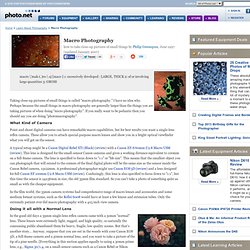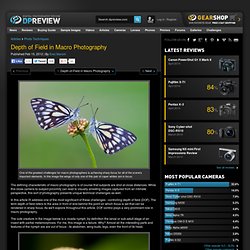

A Beginners Guide to Focus Stacking in Lightroom and Photoshop. Who wouldn’t want their pictures to always come out crisp and clear?

We’ve all had moments where an awesome image turns out to be a bit too soft upon closer inspection. Luckily, a technique known as focus stacking can play a huge role in cutting down focus errors. In short, focus stacking takes the sharpest parts of a few similar photographs to create a composition with greater clarity. And, while the process may sound time-consuming, it actually only takes a few minutes to implement. The Best Focus Stacking Software: The Top Software Compared. DSLR and mirrorless cameras allow a high level of control over our photos.

We can change different settings like shutter speed, ISO, and aperture. These cameras are capable of focusing on single objects and utilizing the depth of field. 7 Best Focus Stacking Software in 2021. Focus stacking software merges several images with different focal points and creates a sharp result.

This depth of field refers to anything from meters to millimeters. If you want to keep a particular item in focus, for example, a plant in the foreground, the house in the background, an object in the frame, etc., you have to spend some time and effort to achieve that goal. That’s when such software comes in handy.
With the best focus stacking software in your arsenal, you can get more control over your images. Learning this technique is very rewarding. 1. Different rendering methods Doesn’t watermark results Multifunctional Fast visualization Easy to work with None Verdict: This is the best focus stacking software for people searching for a free yet robust feature set. It’s easy to work with. Even though the basic process is straightforward, there are many advanced controls for you to use. 2.
The process is simple here but pay attention to alignment when combining layers. 3. 4. 5. 6. Helicon Focus Licenses (SWREG) - Helicon Soft. Helicon Focus Lite = Helicon Focus Lite license Helicon Focus Pro Package = Helicon Focus Pro license + Helicon Remote for desktop computers (Windows, Mac OS X) Helicon Focus Premium Package = Helicon Focus Pro license + Helicon Remote multi-platform (Windows, Mac OS X, Android, iOS) One year license is valid during one year after purchase and reverts to demo mode afterwards.
Home [Zerene Stacker] Extreme Macro Photography. Focus-Stack using Photoshop. A Post By: Don Komarechka One of the biggest challenges facing macro photographers is getting your subject in focus.

Not only is hitting the perfect focus point an exercise in frustration, but often you don’t have enough in focus. Unlike a landscape photographer who can set their aperture to F/22 and be happy, a macro shooter will likely be rewarded by blurry images – and even if they are sharp, the focus still won’t magically spread from edge-to-edge. Remote Focus stacking. Focus stacking is a technique for increasing the depth of field by taking a series of photographs with different focus settings and then combining them together using the areas in focus from each image.

This technique is useful for macro and close-up photography, landscapes, product photography and any other image where the depth of field is critical and the subject isn't moving. The live view display in DSLR Remote Pro makes it very simple to automate the process of taking a sequence of images with different focus settings by running a script.
There is no need to touch the camera and the mirror stays locked up during the sequence which minimizes the chances of camera shake or movement. Once the pictures have been taken they can be combined using free software such as CombineZM or commercial software like Helicon Focus (the example images on this page were combined using CombineZM). Example 1 Model car Combined image from 38 shots taken with Canon EOS 40D, 50mm f/1.8 lens @ f/5.6. Focus Stacking. Editor’s note: This excerpt first appeared in photographer and author Harold Davis’ recent Focal Press book, Photographing Flowers: Exploring Macro Photography with Harold Davis.

The closer you get in macro flower photography, the fussier focus gets. Since “fussy” is not a technical term, let me explain. How-to from Photo.net. How to take close-up pictures of small things by Philip Greenspun, June 1997 (updated January 2007) macro \'mak-(.)ro-\ aj [macr-] 1: excessively developed : LARGE, THICK 2: of or involving large quantities 3: GROSS Taking close-up pictures of small things is called "macro photography.

" I have no idea why. Perhaps because the small things in macro photography are generally larger than the things you are taking pictures of when doing "micro photography". If you really want to be pedantic then you should say you are doing "photomacrography". What Kind of Camera Point and shoot digital cameras can have remarkable macro capabilities, but for best results you want a single-lens reflex camera. A typical setup might be a Canon Digital Rebel XTi (Black) (review) with a Canon EF-S 60mm f/2.8 Macro USM (review). Doing it all with a Normal Lens. Comprehensive Guide. When we photograph something very small we call it a macro photography.

I would imagine we should call it Micro photography, but I don’t have control over the jargon. Shooting small things poses great challenges and comes with high rewards. In this tutorial I to get all the info that you’d need to take macro shots. starting from equipment through subjects and tip and wrap up of some of my favorite macro photographers on Flickr if you need some extra inspiration. Depth of Field in Macro Photography. The defining characteristic of macro photography is of course that subjects are shot at close distances.

While this close camera-to-subject proximity can lead to visually arresting images captured from an intimate perspective, this sort of photography presents unique technical challenges as well. In this article I'll address one of the most significant of these challenges - controlling depth of field (DOF).